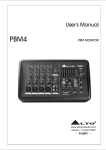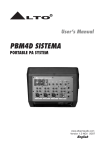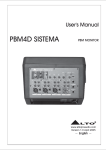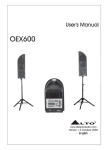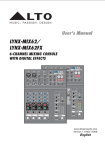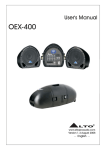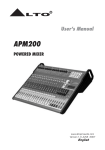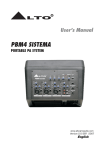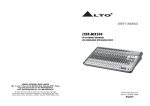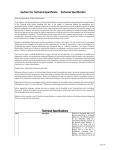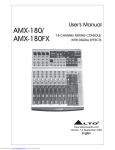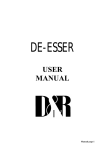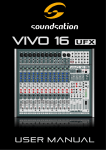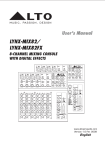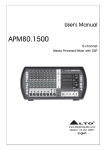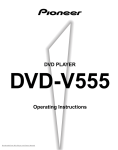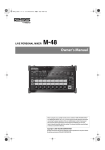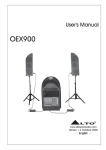Download User Manual
Transcript
R LTO OWNER'S MANUAL PBM4 COMPACT POWERED MIXER www.altoproaudio.com Version 1.2 OCTOBER 2007 English IMPORTANT SAFETY INSTRUCTION CAUTION RISK OF ELECTRIC SHOCK DO NOT OPEN TO REDUCE THE RISK OF ELECTRIC SHOCK PLEASE DO NOT REMOVE THE COVER OR THE BACK PANEL OF THIS EQUIPMENT. THERE ARE NO PARTS NEEDED BY USER INSIDE THE EQUIPMENT. FOR SERVICE, PLEASE CONTACT QUALIFIED SERVICE CENTERS. WARNING To reduce the risk of electric shock and fire, do not expose this equipment to moisture or rain. Dispose of this product should not be placed in municipal waste and should be separate collection. 11. Move this Equipment only with a cart, stand, tripod, or bracket, This symbol, wherever used, alerts you to the specified by the presence of un-insulated and dangerous voltages manufacturer, or within the product enclosure. These are voltages that sold with the may be sufficient to constitute the risk of electric Equipment. When shock or death. a cart is used, use This symbol, wherever used, alerts you to caution when important operating and maintenance instructions. moving the cart / Please read. equipment Protective Ground Terminal combination to AC mains (Alternating Current) avoid possible Hazardous Live Terminal injury from tip-over. ON: Denotes the product is turned on. 12. Permanent hearing loss may be caused by OFF: Denotes the product is turned off. exposure to \ extremely high noise levels. CAUTION The US. Government's Occupational Safety Describes precautions that should be observed to and Health Administration (OSHA) has prevent damage to the product. specified the permissible exposure to noise 1. Read this Manual carefully before operation. level. 2. Keep this Manual in a safe place. These are shown in the following chart: 3. Be aware of all warnings reported with this symbol. HOURS X DAY SPL EXAMPLE 4. Keep this Equipment away from water and 90 Small gig 8 moisture. 92 train 6 5. Clean it only with dry cloth. Do not use 95 Subway train 4 solvent or other chemicals. 97 High level desktop monitors 3 6. Do not damp or cover any cooling opening. 100 Classic music concert 2 Install the equipment only in accordance with 102 1,5 the Manufacturer's instructions. 105 1 7. Power Cords are designed for your safety. Do 110 0,5 not remove Ground connections! If the plug 0,25 or less 115 Rock concert does not fit your AC outlet, seek advice from a qualified electrician. Protect the power According to OSHA, an exposure to high SPL in cord and plug from any physical stress to excess of these limits may result in the loss of avoid risk of electric shock. Do not place heat. To avoid the potential damage of heat, it is heavy objects on the power cord. This could cause electric shock or fire. recommended that Personnel exposed to equipment capable of generating high SPL use 8. Unplug this equipment when unused for long hearing protection while such equipment is periods of time or during a storm. under operation. 9. Refer all service to qualified service personnel The apparatus shall be connected to a mains only. Do not perform any servicing other than those instructions contained within the socket outlet with a protective earthing User's Manual. connection. 10. To prevent fire and damage to the product, use only the recommended fuse type as indicated in this manual. Do not short-circuit the fuse holder. Before replacing the fuse, make sure that the product is OFF and disconnected from the AC outlet. The mains plug or an appliance coupler is used as the disconnect device, the disconnect device shall remain readily operable. IN THIS MANUAL: 1. 2. 3. 4. 5. 6. 7. 8. 9. INTRODUCTION........................................................................1 FEATURES...............................................................................1 QUICK START...........................................................................3 CONTROL ELEMENTS...............................................................5 INSTALLATION & CONNECTION................................................10 PRESET LIST...........................................................................12 BLOCK DIAGRAM...................................................................13 TECHNICAL SPECIFICATIONS....................................................14 WARRANTY...........................................................................15 1. INTRODUCTION Thank you for your purchasing of the LTO PBM4 compact mixer with digital multieffect and 140 watt amplifier built in. It is just one of the many LTO products that a talented, multinational Team of Audio Engineers and Musicians have developed with their great passion for music. Your PBM4 is a remarkable and unique equipment that doesn't find equals in the market of compact powered mixing consoles. With enough microphone and Line-level inputs for serious, small live performances, your PBM4 also includes a 24 Bit digital multieffect with 16 Factory Presets. The built-in amplifier is capable to deliver 200 watt in total. Enjoy your PBM4 and make sure to read this Manual carefully before operation! 2. FEATURES 70W x 2@4 ohm, offering high power and high dynamic range 7-band graphic EQ on Master 4 MIC/line input channels with balanced XLR and TRS inputs Ultra-low noise discrete MIC pre-amps with +15V phantom power 2-band EQ on mono input channels FX send for built-in or external effects Separate output for stage monitor Tape in/out with level control 16-preset digital effect processor 1 8 8 M +10dB AUX1 POST +10dB +10dB +10dB CH 1 CH 5-6 MIC IN (bal.) TAPE OUT 3 P 3 CH 4 TAPE IN LEVEL +10dB MIC IN (bal.) OFF ON PHANTOM - MONITOR - 0 dB CH 3 1 RE A LINE IN (bal.) LOW NOISE P 2 80Hz DSP/FX +15dB LOW +15dB LEVEL 0 dB 0dB 0dB MIC IN (bal.) 1 - - -15dB -15dB CH 2 P MIC IN (bal.) 2 RE A LINE IN (bal.) LOW NOISE P P 3 1 M P 3 2 AUX1 POST +10dB LEVEL 0 dB 80Hz DSP/FX +15dB LOW +15dB M 1 RE A LINE IN (bal.) LOW NOISE P - - 0dB 0dB 12KHz HIGH M 2 8 RE A +10dB +10dB AUX1 POST -15dB -15dB 8 LINE IN (bal.) 8 8 LEVEL 0 dB 80Hz DSP/FX +15dB LOW +15dB 0dB 2.5K 6.3K 16K 14 12 13 11 15 9 1 8 2 7 3 6 5 4 0 10 CLIP 2 -30 -10 1. 2. 3. 4. 5. 6. 7. 8. 9. 10. 11. 12. 13. 14. 15. 16. WARM HALL BRIGHT HALL WARM ROOM BRIGHT ROOM VOCAL 1 VOCAL 2 VOCAL 3 PLATE STEREO DELAY1 STEREO DELAY2 REV + DELAY1 REV + DELAY2 REV + DELAY3 REV + DELAY4 REV + CHORUS1 REV + CHORUS2 PRESETS MONITOR OUT MUTE AUX/DFX RET DSP MUTE POWER AMPLIFIER OUTPUT 1 PRESETS 10 16 DSP 15 1K 15 400 9 9 160 0 0 63 9 9 0 15 10 15 R LTO LEVEL +10dB FOOTSWITCH FX RETURN FX SEND - 0 dB OPERATING MAIN PBM4 8 LOW NOISE P - - 0dB 0dB 8 +10dB +10dB AUX1 POST -15dB -15dB 12KHz HIGH 8 LEVEL 80Hz DSP/FX +15dB LOW +15dB 0dB 8 - 0 dB 0dB 0dB 12KHz HIGH 8 - -15dB -15dB 12KHz 0dB IG HIGH OT L 0dB SP HT 2 3. QUICK START This is the fastest way to get something out from your PBM4, if you have a keyboard and a microphone. a. Before connecting microphones or instruments, make sure that the power of all your systems components including your PBM4 is turned off. Also, make sure that all input and output controls are turned down. This will avoid damage to your speakers and excessive noise. b. Properly connect all external equipments such as microphone, processors, speakers etc. c. Now, turn on the power of any peripheral devices, and then connect your . PBM4 to the AC socket. Note: Powered monitors or power amplifiers shall be turned ON after the PBM4 is on and OFF before turned the PBM4 off. d. Set the output level of your PBM4 at no more than 75%. e. Set HI, and LOW EQ controls on center position. f. Set the Master EQ slider on center position . g. Set panoramic (PAN/BAL) control on center position. h. While speaking into the microphone (or playing the instrument) at normal volume, adjust the channel Level control so that you wouldn't hear any distortion. i. You can shape the tone of each channel by adjusting the equalizer controls as desired. j. Now repeat the same sequence for all input channels. The Main LED Meter could move up into the red section. In this case you can adjust the overall output level through the main LEVEL control. HOOK PBM4 IN CONFERENCE UP Wireless Microphone 1 0dB 0dB 0dB HIGH 0dB HIGH 12KHz +15dB -15dB 12KHz +15dB -15dB 0dB LOW MAIN 0 dB 0dB LOW PBM4 LTO HIGH 12KHz +15dB -15dB 0dB LOW R HIGH 12KHz +15dB -15dB 0dB LOW 15 15 10 9 9 OPERATING 80Hz -15dB +15dB 0dB 0dB 0dB 80Hz -15dB +15dB AUX1 POST - 0dB DSP/FX DSP/FX +15dB DSP/FX AUX1 POST DSP/FX AUX1 POST AUX1 POST +10dB MONITOR 0 0 9 0 dB - +10dB 0 dB - +10dB 8 - +10dB 8 0 dB 8 8 - 0 dB LEVEL LEVEL - 63 - LEVEL 8 +10dB 8 - +10dB 8 8 - +10dB 8 - +10dB LEVEL PHANTOM +10dB LEVEL ON 160 400 LINE IN (bal.) LOW NOISE P LINE IN (bal.) LOW NOISE P RE A 2 1 1 2 TAPE IN 6.3K CLIP DSP MUTE MUTE 3 4 5 6 12 11 7 10 9 8 PRESETS RE A 2.5K 0 10 AUX/DFX RET 2 +10dB 16K PRESETS 1. 2. 3. 4. 5. 6. 7. 8. 9. 10. 11. 12. 13. 14. 15. 16. WARM HALL BRIGHT HALL WARM ROOM BRIGHT ROOM VOCAL 1 VOCAL 2 VOCAL 3 PLATE STEREO DELAY1 STEREO DELAY2 REV + DELAY1 REV + DELAY2 REV + DELAY3 REV + DELAY4 REV + CHORUS1 REV + CHORUS2 FX SEND FX RETURN P 1 16 1K M 2 P P P 1 LINE IN (bal.) LOW NOISE P RE A M M M 2 LINE IN (bal.) LOW NOISE P RE A 15 14 13 OFF LEVEL -30 15 +10dB DSP - 0 dB -10 9 15 MIC 0 8 80Hz -15dB +15dB 8 80Hz -15dB 1 1 3 3 3 3 MIC IN (bal.) MIC IN (bal.) MIC IN (bal.) MIC IN (bal.) TAPE OUT CH 1 CH 2 CH 3 CH 4 CH 5-6 POWER AMPLIFIER OUTPUT Main Speakers 2 MONITOR OUT FOOTSWITCH MULTIMEDIA PRESENTATION Wireless Microphone 2 CD Player 3 Tape Recorder Secondary Speaker HOOK PBM4 IN SMALL GIG UP Drum Machine 0dB 0dB 0dB HIGH 0dB HIGH 12KHz +15dB -15dB 12KHz +15dB -15dB 0dB LOW MAIN 0 dB 0dB LOW PBM4 LTO HIGH 12KHz +15dB -15dB 0dB LOW R HIGH 12KHz +15dB -15dB 0dB LOW 15 15 10 9 9 OPERATING 0dB 0 dB 8 8 MIC DSP/FX AUX1 POST 0 dB DSP/FX AUX1 POST - +10dB 0 dB - 0dB DSP/FX AUX1 POST - +15dB MONITOR AUX1 POST - +10dB 0 dB +10dB 0 0 9 9 15 15 LEVEL LEVEL 63 +10dB 8 - LEVEL LEVEL PHANTOM 160 400 LINE IN (bal.) LINE IN (bal.) LOW NOISE P RE A 2 6.3K PRESETS CLIP DSP MUTE 1. 2. 3. 4. 5. 6. 7. 8. 9. 10. 11. 12. 13. 14. 15. 16. MUTE 3 5 6 7 11 10 9 8 0 PRESETS 1 2 10 AUX/DFX RET WARM HALL BRIGHT HALL WARM ROOM BRIGHT ROOM VOCAL 1 VOCAL 2 VOCAL 3 PLATE STEREO DELAY1 STEREO DELAY2 REV + DELAY1 REV + DELAY2 REV + DELAY3 REV + DELAY4 REV + CHORUS1 REV + CHORUS2 FX SEND FX RETURN 1 1 3 3 3 3 MIC IN (bal.) MIC IN (bal.) MIC IN (bal.) MIC IN (bal.) TAPE OUT CH 1 CH 2 CH 3 CH 4 CH 5-6 Keyboard +10dB 16K P 1 2.5K M P 2 1K 4 RE A M HOOK P P Wireless Microphone 1 2 12 TAPE IN LINE IN (bal.) LOW NOISE P RE A M M 2 LINE IN (bal.) LOW NOISE P RE A 1 13 OFF LOW NOISE P 16 15 14 ON LEVEL -30 - +10dB 8 - +10dB 8 8 - +10dB 8 - +10dB LEVEL 0 dB -10 +10dB DSP - 0 8 0dB DSP/FX +10dB 80Hz -15dB +15dB 8 0dB - 80Hz -15dB +15dB 8 Guitar 80Hz -15dB +15dB 8 80Hz -15dB Main Speakers 2 POWER AMPLIFIER OUTPUT MONITOR OUT FOOTSWITCH Stage Monitor Tape Recorder CD Player PBM4 IN BAR-PUB UP Zone 3 Speakers Wireless Microphone 0dB 0dB 0dB HIGH 0dB HIGH 12KHz +15dB -15dB 12KHz +15dB -15dB 0dB LOW MAIN 0 dB 0dB LOW PBM4 LTO HIGH 12KHz +15dB -15dB 0dB LOW R HIGH 12KHz +15dB -15dB 0dB LOW 15 15 10 9 9 0 0 OPERATING 0dB 0dB DSP/FX 0 dB 0 dB - DSP/FX AUX1 POST - +10dB 8 AUX1 POST - 8 MIC 8 AUX1 POST +10dB +15dB 0dB DSP/FX DSP/FX 0 dB 80Hz -15dB +15dB AUX1 POST - +10dB 8 0dB - 80Hz -15dB +15dB 0 dB +10dB MONITOR 9 9 15 15 LEVEL LEVEL 63 8 - LEVEL PHANTOM +10dB LEVEL ON 160 400 LINE IN (bal.) LOW NOISE P LINE IN (bal.) LOW NOISE P RE A 2 1 1 2 TAPE IN 6.3K CLIP DSP MUTE MUTE 3 4 5 6 12 RE A 2.5K 11 7 10 9 8 0 10 PRESETS AUX/DFX RET 2 1 2 +10dB 16K PRESETS 1. 2. 3. 4. 5. 6. 7. 8. 9. 10. 11. 12. 13. 14. 15. 16. WARM HALL BRIGHT HALL WARM ROOM BRIGHT ROOM VOCAL 1 VOCAL 2 VOCAL 3 PLATE STEREO DELAY1 STEREO DELAY2 REV + DELAY1 REV + DELAY2 REV + DELAY3 REV + DELAY4 REV + CHORUS1 REV + CHORUS2 FX SEND Power Amplifier FX RETURN P 1 16 1K M 2 P P P 1 LINE IN (bal.) LOW NOISE P RE A M M M 2 LINE IN (bal.) LOW NOISE P RE A 15 14 13 OFF LEVEL -30 - +10dB 8 - +10dB 8 8 - +10dB 8 - +10dB LEVEL 0 dB -10 +10dB DSP - 0 8 80Hz -15dB +15dB 8 80Hz -15dB 1 3 3 3 3 MIC IN (bal.) MIC IN (bal.) MIC IN (bal.) MIC IN (bal.) TAPE OUT CH 1 CH 2 CH 3 CH 4 CH 5-6 POWER AMPLIFIER OUTPUT MONITOR OUT TV SCREEN FOOTSWITCH Audio Form Screen TV Keyboard Drum Machine CD Player Tape Recorder Zone 1 Speakers Zone 2 Speakers 4 SP OT L IG 4. 3. CONTROL ELEMENTS HT INPUT SECTION 1 MONO MIC/LINE CHANNELS HIGH 12KHz +15dB -15dB 0dB LOW 6 80Hz -15dB +15dB 0dB DSP/FX AUX1 POST - 8 4 0 dB +10dB 3 +10dB 8 - LEVEL 1 LINE IN (bal.) LOW NOISE P RE A P NOTE: Never try to connect a line-level signal to the XLR MIC input when the phantom power is engaged or you may seriously damage your equipment. 0dB 5 M Your PBM4 is equipped with 4 low-noise, microphone preamplifiers with optional phantom power supplying +15 Volt. You can connect almost any type of microphone. Dynamic microphones do not need phantom power. Use phantom power only with condenser microphones but make sure that the phantom power button is disengaged before connecting the microphone. Phantom power will not damage your dynamic microphones but it may damage tube or ribbon microphones so make sure to read the microphone instructions manual before engage phantom power. Use switch (2) to activate/deactivate phantom power. These two channels are also equipped with 1/4" TRS balanced/unbalanced plugs to connect line-level instruments such as keyboards, drum machines and effect devices. 2 1 3 MIC IN (bal.) CH 1 2 +15V PHANTOM POWER SWITCH This switch will apply +15 Volt Phantom Power only to the 4 XLR inputs sockets. 3 LEVEL CONTROL This control is used to adjust the overall level of respective channel. The adjustable range goes from - to +10dB. . 4 DSP/FX-AUX This control is used to adjust the level of respective channel signal sent to the Auxiliary Bus. The configuration is post-fader so the signal sent to the AUX Bus will be affected by the LEVEL control of that particular channel. In this typical compact unit, the channel signal is not only assigned to external effect or processor equipment directly but also to internal digital multieffect. EQUALIZATION You have two EQ controls for each mono input channel each providing +/-15 dB of boost and cut. The signal will be unaffected when the controls are on center position. 5 IG 4. 3. CONTROL ELEMENTS HT 5 HI If you turn this control up, you will boost all the frequencies above 12 kHz (shelving filter). You will add transparency to vocals and guitar and also make cymbals crispier. Turn the control down to cut all frequencies above 12 KHz. In such way, you can reduce sibilances of human voice or reduce the hiss of a Tape player. 6 LOW 0 dB 10 - 8 OT L 9 - If you turn this control up, you will boost all frequencies below 80 Hz. You will give more punch to bass drums and bass guitar; and you will make the male vocalist more "macho". Turn it down and you will cut all the frequencies below 80 Hz. In this way, you can avoid low-frequency vibrations and resonance thus preserving the life of your woofers. +10dB MONITOR 8 SP PHANTOM 2 +10dB LEVEL ON OFF TAPE IN 7 8 TAPE OUT 11 CH 5-6 7 TAPE IN Your PBM4 features dual RCA jacks (left and right). If you wish to listen to your monitor from a tape recorder, DAT or cassette, please use these tape input jacks. You can connect the outputs of a CD Player, MP3 Player, iPOD or another line-level stereo source to these RCA sockets and adjust the level control. It is a very useful extra stereo channel. 8 TAPE OUT Via these jacks, you can route the main out signal into a tape recorder or DAT to record your event. 9 LEVEL This knob will control the level of the signal applied to TAPE IN RCA input. 10 MONITOR This knob will control the level of the signal sent to the monitor output 11 GRAPHIC EQ Your PBM4 is equipped with a 7-bands graphic equalizer. Via these faders, you can boost or attenuate the selected frequency by 15dB at a preset bandwidth. When all faders are on center position, the signal will be unaffected. 6 SP OT L IG 4. CONTROL CONTROLELEMENTS ELEMENTS 3. HT 12 MAIN LEVEL This control sets the amount of signal simultaneously sent to the MAIN MIX OUTPUT and TAPE OUT. MAIN 15 15 10 9 9 0 0 14 OPERATING 11 9 9 15 15 0 13 0 dB -10 LEVEL 12 - 63 160 400 1K 2.5K 6.3K 8 -30 +10dB 16K 13 LED METER This meter has 4 leds with range of 30 dB to +10 dB (CLIP). The 0 led corresponds to a level output of 0 dBu.The +10 led comes to life when the output reaches +10 dBu. Set the MAIN LEVEL control so that the 10 led only flashes occasionally. In general you get a good mix level when the Meter leds operates in the range 10 to 0. If you exceed 0, you will get distortion. If even 30 leds are sleeping your signal-to-noise ratio will suffer. 14 OPERATING This LED indicates when your PBM4 is switched-on. MASTER SECTION AND CONNECTIONS 22 DSP 15 16 1 2 MUTE 3 4 5 13 6 12 11 21 CLIP DSP MUTE 14 20 23 7 10 9 8 PRESETS 0 10 AUX/DFX RET PRESETS 1. 2. 3. 4. 5. 6. 7. 8. 9. 10. 11. 12. 13. 14. 15. 16. WARM HALL BRIGHT HALL WARM ROOM BRIGHT ROOM VOCAL 1 VOCAL 2 VOCAL 3 PLATE STEREO DELAY1 STEREO DELAY2 REV + DELAY1 REV + DELAY2 REV + DELAY3 REV + DELAY4 REV + CHORUS1 REV + CHORUS2 18 FX SEND 19 FX RETURN 1 7 2 POWER AMPLIFIER OUTPUT MONITOR OUT FOOTSWITCH 15 16 17 SP OT L IG 4. 3. CONTROL ELEMENTS HT 15 POWER AMPLIFIER OUTPUT The TWO jacks are used to output the main mix signal into external passive speakers. 16 MONITOR OUTPUT This jack is used to connect the input of external active monitor speaker or power amplifier. If you connect a stereo amplifier you can use it in PARALLEL MONO Mode. In this way you will use only one input channel of the amplifier but you still have available 2 separate output channels each one with its own volume control. 17 FOOTSWITCH You can connect an optional external footswitch to turn on/off the onboard multieffects module. It is a 1/4 " phone jack. 18 FX SEND This 1/4" phone socket is used to send out the signal from the AUX bus of the input channels into external devices such as effect units. 19 FX RETURNS You can use this stereo 1/4" phone socket to return the signal of an effect unit to the Main Mix. Alternatively you can use IT as an extra auxiliary input using the AUX RETURN level control as volume control. DSP SECTION Your PBM4 features a 24-bit, 16-presets digital multieffects including reverbs, chorus, vocal and delay, etc. 20 PRESETS Adjust this knob to select the desired effect. 21 AUX/DFX RET This control is used to adjust the level of the return signal coming from external/internal multieffect effect. The signal of the AUX RETURN will be sent to MAIN MIX OUTPUT. If you connect a sound source to the FX RETURN input such as CD Players, etc, you can use this knob to control the input level of such source. 22 DSP MUTE This switch is used to activate/deactivate the resident multieffect. Alternatively, you can also use the FOOTSWITCH jack. 8 SP OT L IG 4. 3. CONTROL ELEMENTS HT 23 CLIP/MUTE This LED lights up when the input signal is too strong. In case of the digital effect module being muted, this LED also lights up. REAR PANEL 24 POWER ON/OFF This switch is used to turn the main power ON/OFF. 25 AC INLET with FUSE 2A Use it to connect your PBM4 to the main AC with the supplied AC cord. Please check the voltage available in your country and how the voltage for your PBM4 is configured before attempting to connect your PBM4 to the main AC. POWER ON OFF 24 9 FUSE 2A AC~230V 50/60Hz 25 5. INSTALLATION AND CONNECTION Ok, you have got to this point and you are now in the position to successfully operate your PBM4. However, we advise you to read carefully the following section to be the real master of your own mix. Not paying attention enough to the input signal level, to the routing of the signal and the assignment of the signal will result in unwanted distortion, a corrupted signal or no sound at all. So you should follow this procedure for every single channel: 1. Turn down all Input and output gain controls. 2. Connect phantom powered microphones before switching on the +15 Volt phantom power switch. 3. Set the output level of your PBM4 or the connected power amplifier at no more than 75%. 4. Now, set the MONITOR level at no more than 50%. In this way you will be able to hear later what you are doing connecting a pair of headphones or a pair of powered studio monitor speakers. 5. Position EQ controls on middle position. 6. Increase the input gain properly for maintaining the good headroom and ideal dynamic range. 7. Depending on the actual application, turn slowly the input and output level controls for obtaining the maximum gain before distortion. 8. Now repeat the same sequence for all input channels. The main LED meter could move up into the red section. In this case you can adjust the overall output level through the MAIN MIX control. Audio Connections You can connect unbalanced equipment to balanced inputs and outputs. Simply follow these schematics. Sleeve Tip Ring Ring=Right Signal Strain Clamp Tip=Left Signal Sleeve=Ground/Screen Use for Headphone 1/4" Stereo (TRS) Jack Plug Sleeve Tip Tip=Signal Strain Clamp Sleeve=Ground/Screen Use for Mono Line In, Mono 1/4"Jack Plugs 1/4" Mono (TS) Jack Plug 10 5. AND CONNECTION 3. INSTALLATION CONTROL ELEMENTS Sleeve Ring=Return Signal Tip Ring Strain Clamp Tip=Send Signal Sleeve=Ground/Screen Use for Insert Points 1/4" Stereo (TRS) Jack Plug 2=Hot(+) 2 3 1 1=Ground/Screen 2 2=Hot(+) 3 1 1=Ground/Screen 3=Cold(-) 3=Cold(-) Use for Balanced Mic Inputs (For unbalanced use, connect pin 1 to 3) Use for Main output (For unbalanced use, leave pin3 unconnected) 3-pin XLR Male Plug 3-pin XLR Line Socket (seen from soldering side) (seen from soldering side) MAIN SPEAKERS CONNECTION Please use only the power connectors to make connections with other signal source equipment for the passive speaker cabinets. The power connector has four terminals: 1+, 1-, 2+, 2-. 1- 2- 1+ 2+ Speakon connector 11 6. PRESET LIST NO. Preset Description Controllable Parameter Parameter Variable range 1 WARM HALL Simulate a small acoustic space of the sound. Rev.decay time Pre-delay 360ms 45ms 2 BRIGHT HALL Simulate a large acoustic space of the sound. Rev.decay time Pre-delay 290ms 23ms 3 WARM ROOM Simulate a small acoustic space of the sound. Rev.decay time Pre-delay 210ms 45ms 4 BRIGHT ROOM Simulate a studio room with many early reflections Rev.decay time Pre-delay 210ms 23ms 5 VOCAL1 Simulate a room with delay time. Rev.decay time 450ms 6 VOCAL2 Simulate a room with small delay time. Rev.decay time Pre-delay 240ms 25ms 7 VOCAL3 Simulate a small space with slight decay time. Rev.decay time Pre-delay 100ms 114ms 8 PLATE Simulate the transducers sound like classic bright vocal plate. Rev.decay time Pre-delay 290ms 10ms 9 STEREO DELAY 1 Recreate the input sound on the stereo output with different time. Period 352ms 10 STEREO DELAY 2 Recreate the input sound on the stereo output with different time. Period 238ms 11 REV + DELAY 1 Delay with room effect. Delay period Rev.decay time 326ms 290ms 12 REV + DELAY 2 Delay with room effect. Decay period Rev.decay time 211ms 240ms 13 REV + DELAY 3 Delay with room effect. Decay period Rev.decay time 375ms 210ms 14 REV + DELAY 4 Delay with room effect. Decay period Rev.decay time 277ms 150ms 15 REV + CHORUS1 Stereo chorus and large room reverb Chorus rate Rev.decay time 3.67Hz 290ms REV + CHORUS2 Stereo chorus and large room reverb Chorus rate Rev.decay time 3.02Hz 150ms 12 7. BLOCK DIAGRAM 13 6. 8. TECHNICAL TECHNICALSPECIFICATIONS SPECIFICATION Input channels Microphone Input Frequency response Distortion(THD&N) Gain SNR(Signal to Noise Ratio) Line input Frequency response Distortion(THD&N) Gain Impedances Microphone Input Channel Insert return All other inputs Tape out All other outputs Equalization Hi shelving Low shelving DSP Section A/D and D/A converters DSP resolution Type of effects Presets Controls Main Mix Section Noise(Bus noise) Monitor max out FX Sends max out Amplifier Section Output Power Frequency Response Output Impedance Power Supply Main voltage Power Consumption Fuse Physical Dimension Net Weight Gross Weight Noise (Bus noise) Electronically balanced, discrete input configuration 10 Hz to 55 kHz, +/- 3 dB 0.05% at +4 dBu, 1 kHz 30 dB >94 dB Electronically balanced 10 Hz to 55 kHz, +/- 3 dB 0.05% at +4 dBu, 1 kHz 10 dB 1.4 kOhm 2.5 kOhm 10 kOhm or greater 1 kOhm 120 Ohm +/-15 dB@12 kHz +/-15 dB@80 Hz 24bit 24bit HALL, ROOM, VOCAL, PLATE, STEREO DELAY REV+DELAY, and REV+CHORUS combinations 16 16-position PRESET selector CLIP LED MUTE SWITCH with LED indicator Fader 0 dB, channels muted: -85 dBr (ref.: +4 dBu) Fader 0 dB, all input channels assigned and set to UNITY gain: -81 dBr(ref.: +4 dBu) +22 dBu unbalanced, 1/4"jacks +22dBu 70W x 2 RMS (Nominal power) 25 Hz-20 kHz 8 ohm 82W x 2(EIAJ) USA/Canada 100 120V~, 60 Hz Europe 210 240V~, 50 Hz U.K./Australia 240V~, 50Hz 260 watts 100-120V~: T4A 21 0-240V~: T2A 216.5x143.5x152.5mm(LxWxH)(8.5"x5.6"x6") 9.5 Kg 11.340Kg Fader dB, channels muted: 85dBr (ref.:+4dBu) 14 8. WARRANTY 1. WARRANTY REGISTRATION CARD To obtain Warranty Service, the buyer should first fill out and return the enclosed Warranty Registration Card within 10 days of the Purchase Date. All the information presented in this Warranty Registration Card gives the manufacturer a better understanding of the sales status, so as to provide a more effective and efficient after-sales warranty service. Please fill out all the information carefully and genuinely, miswriting or absence of this card will void your warranty service. 2. RETURN NOTICE 2.1 In case of return for any warranty service, please make sure that the product is well packed in its original shipping carton, and it can protect your unit from any other extra damage. 2.2 Please provide a copy of your sales receipt or other proof of purchase with the returned machine, and give detail information about your return address and contact telephone number. 2.3 A brief description of the defect will be appreciated. 2.4 Please prepay all the costs involved in the return shipping, handling and insurance. 3. TERMS AND CONDITIONS 3.1 LTO warrants that this product will be free from any defects in materials and/or workmanship for a period of 1 year from the purchase date if you have completed the Warranty Registration Card in time. 3.2 The warranty service is only available to the original consumer, who purchased this product directly from the retail dealer, and it can not be transferred. 3.3 During the warranty service, LTO may repair or replace this product at its own option at no charge to you for parts or for labor in accordance with the right side of this limited warranty. 3.4 This warranty does not apply to the damages to this product that occurred as the following conditions: Instead of operating in accordance with the user's manual thoroughly, any abuse or misuse of this product. Normal tear and wear. The product has been altered or modified in any way. Damage which may have been caused either directly or indirectly by another product / force / etc. Abnormal service or repairing by anyone other than the qualified personnel or technician. And in such cases, all the expenses will be charged to the buyer. 3.5 In no event shall LTO be liable for any incidental or consequential damages. Some states do not allow the exclusion or limitation of incidental or consequential damages, so the above exclusion or limitation may not apply to you. 3.6 This warranty gives you the specific rights, and these rights are compatible with the state laws, you may also have other statutory rights that may vary from state to state. 15 SEIKAKU TECHNICAL GROUP LIMITED NO. 1, Lane 17, Sec. 2, Han Shi West Road, Taichung 40151, Taiwan http://www.altoproaudio.com Tel: 886-4-22313737 email: [email protected] Fax: 886-4-22346757 All rights reserved to ALTO. All features and content might be changed without prior notice. Any photocopy, translation, or reproduction of part of this manual without written permission is forbidden. Copyright c 2007 Seikaku Group NF02055-1.2


















